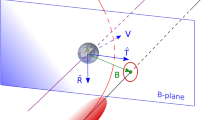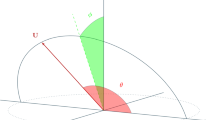Abstract
Close planetary encounters play an important role in the evolution of the orbits of small Solar system bodies and are usually studied with the help of numerical integrations. Here we study close encounters in the framework of an analytic theory, focusing on the so-called b-plane, which is the plane centred on the planet and perpendicular to the planetocentric velocity at infinity of the small body. As shown in previous papers, it is possible to identify the initial conditions on the b-plane that lead to post-encounter orbits of given semimajor axis. In this paper we exploit analytical relationships between b-plane coordinates and pre-encounter orbital elements and compute the probability of transition to these post-encounter states, and numerically check the validity of the analytic approach.




Similar content being viewed by others
References
Carusi, A., Pozzi, F.: Planetary close encounters between Jupiter and about 3000 fictitious minor bodies. Moon Planets 19, 71 (1978)
Carusi, A., Kresáková, M., Valsecchi, G.B.: Perturbations by Jupiter of the particles ejected from Comet Lexell. Astron. Astrophys. 116, 201 (1982)
Carusi, A., Valsecchi, G.B., Greenberg, R.: Planetary close encounters: geometry of approach and post-encounter orbital parameters. Celest. Mech. Dyn. Astron. 49, 111 (1990)
Chesley, S.R.: Potential impact detection for Near-Earth asteroids: the case of 99942 Apophis (2004 \(\text{ MN }_4\)). In: Lazzaro, D., Ferraz-Mello, S., Fernández, J.A. (eds.) Proceedings of IAU Symposium, vol. 229, p. 215. Cambridge University Press, Cambridge, UK (2006)
Everhart, E.: Close encounters of comets and planets. Astron. J. 74, 735 (1969)
Everhart, E.: An efficient integrator that uses Gauss–Radau spacings. In: Carusi, A., Valsecchi, G.B. (eds.) Dynamics of Comets: Their Origin and Evolution, p. 185. Reidel, Dordrecht (1985)
Froeschlé, Cl, Rickman, H.: A Monte Carlo investigation of Jovian perturbations on short-period comet orbits. Icarus 46, 400 (1981)
Kizner, W.: A method of describing miss distances for lunar and interplanetary trajectories. Planet. Space Sci. 7, 125 (1961)
Letizia, F., Colombo, C., Van den Eynde, J., Armellin, R., Jehn, R.: SNAPPSHOT: suite for the numerical analysis of planetary protection. In: Proceedings of the 6th International Conference on Astrodynamics Tools and Techniques (ICATT), 14–17 Mar 2016, Darmstadt (2016)
Milani, A., Chesley, S.R., Sansaturio, M.E., Tommei, G., Valsecchi, G.B.: Nonlinear impact monitoring: line of variation searches for impactors. Icarus 173, 362 (2005)
Oikawa, S., Everhart, E.: Past and future orbit of 1977 UB, object Chiron. Astron. J. 84, 134 (1979)
Öpik, E.J.: Interplanetary Encounters. Elsevier, Amsterdam (1976)
Scholl, H.: History and evolution of Chiron’s orbit. Icarus 40, 345 (1979)
Tisserand, M.F.: Sur la théorie de la capture des comètes périodiques. Bull. Astron. 6, 289 (1889)
Valsecchi, G.B.: Geometric conditions for quasi-collisions in Öpik’s theory. Lect. Notes Phys. 682, 145 (2006)
Valsecchi, G.B., Milani, A., Gronchi, G.F., Chesley, S.R.: The distribution of energy perturbations at planetary close encounters. Celest. Mech. Dyn. Astron. 78, 83 (2000)
Valsecchi, G.B., Milani, A., Gronchi, G.F., Chesley, S.R.: Resonant returns to close approaches: analytical theory. Astron. Astrophys. 408, 1179 (2003)
Valsecchi, G.B., Rossi, A., Milani, A., Chesley, S.R.: The size of collision solutions in orbital elements space. In: Knežević, Z., Milani, A. (eds.) Dynamics of Populations of Planetary Systems, p. 249. Cambridge University Press, Cambridge (2005)
Valsecchi, G.B., Alessi, E.M., Rossi, A.: An analytical solution for the swing-by problem. Celest. Mech. Dyn. Astron. 123, 151 (2015a)
Valsecchi, G.B., Alessi, E.M., Rossi, A.: Erratum to: Celest Mech Dyn Astr (2015) 123(2) https://doi.org/10.1007/s10569-015-9631-6. Celest. Mech. Dynam. Astron. 123, 167 (2015b)
Acknowledgements
We are grateful to D. Farnocchia for his very useful comments.
Author information
Authors and Affiliations
Corresponding author
Additional information
This article is part of the topical collection on Close Approaches and Collisions in Planetary Systems.
Guest Editors: Rudolf Dvorak, Christoph Lhotka and Alessandra Celletti.
Appendix: From coordinates and velocity components at closest approach to b-plane coordinates
Appendix: From coordinates and velocity components at closest approach to b-plane coordinates
We give here explicit formulae to derive \(U, \theta , \phi , \xi , \zeta \) from the planetocentric coordinates and velocity components at closest approach obtained by a numerical integration of the restricted, circular, 3-dimensional 3-body problem.
Let \(X_q, Y_q, Z_q, V_x, V_y, V_z\) be the coordinates and velocity components of the small body at the time of closest approach to the planet, in the reference frame of Sect. 2. Then:
Rights and permissions
About this article
Cite this article
Valsecchi, G.B., Alessi, E.M. & Rossi, A. Cartography of the b-plane of a close encounter I: semimajor axes of post-encounter orbits. Celest Mech Dyn Astr 130, 8 (2018). https://doi.org/10.1007/s10569-017-9810-8
Received:
Revised:
Accepted:
Published:
DOI: https://doi.org/10.1007/s10569-017-9810-8




